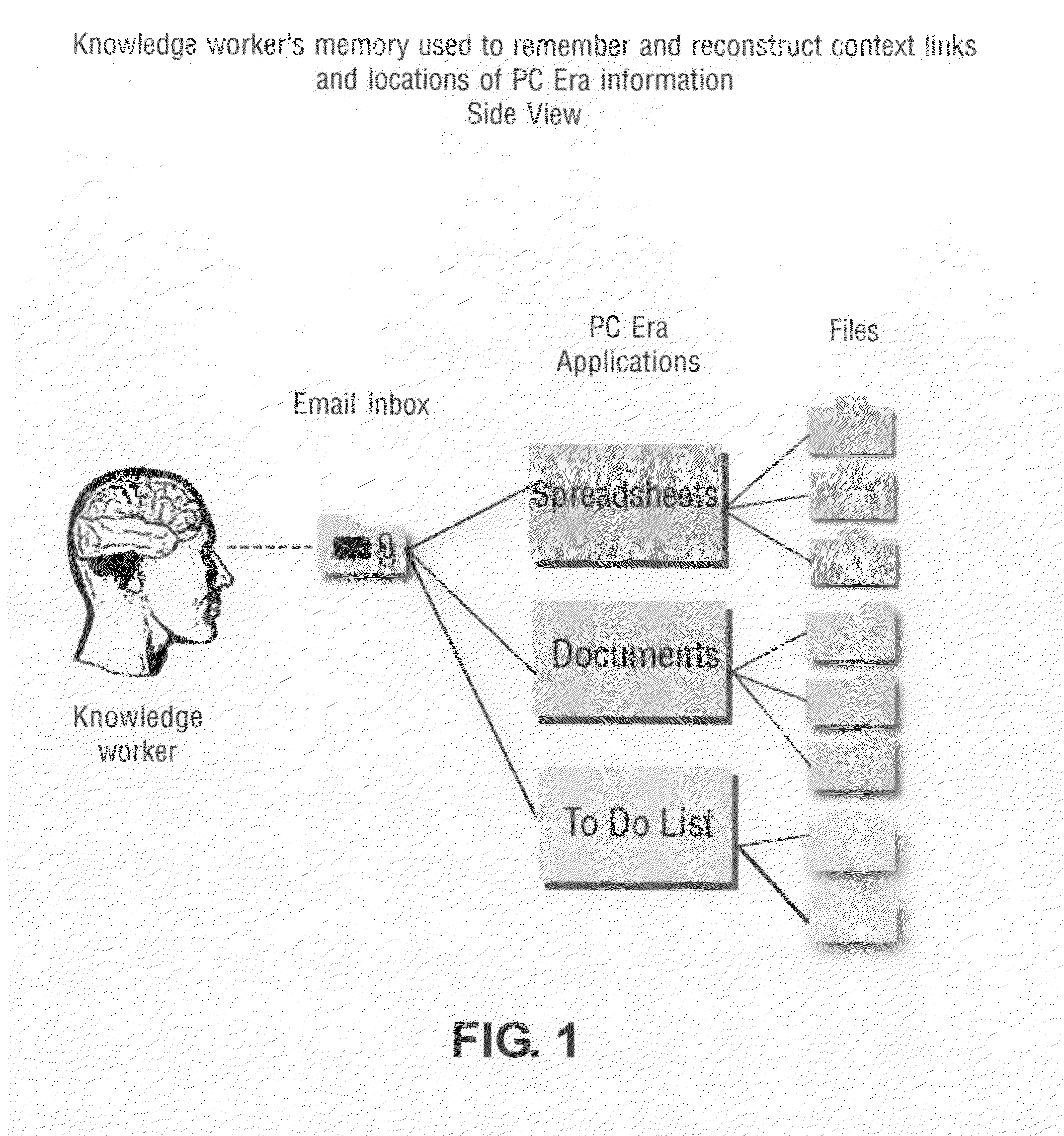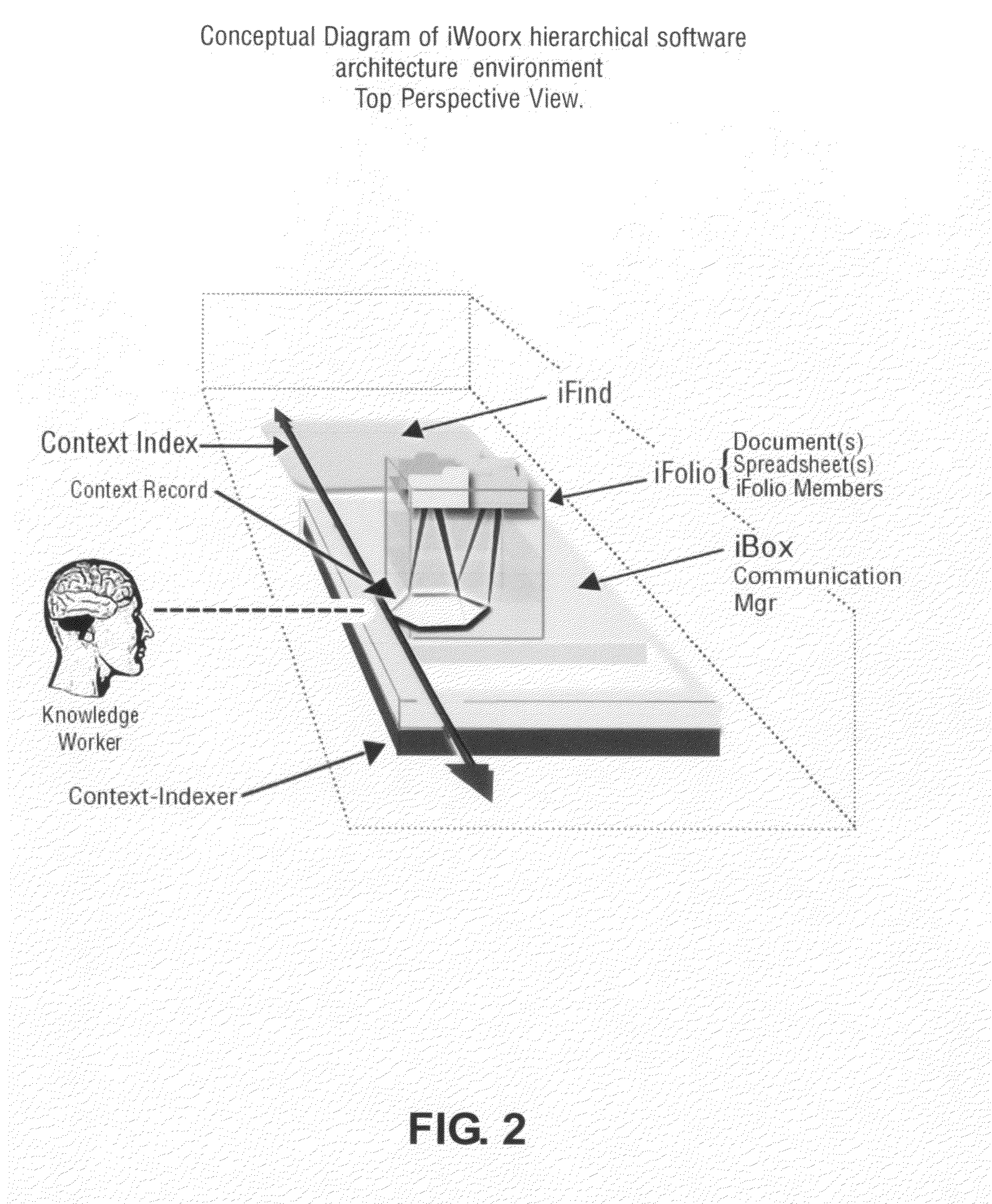Such PC Era application are not designed for contextual communication and information management needed by today's users and organizations.
Today's networked information environment is dynamic and complex and requires
software applications and information management tools that support more effective
information sharing and search (e.g. retrieval) capabilities than typical non-contextual communication and information management
software can provide currently.
Today, organizational and individual inefficiencies result from unmet organizational information management needs.
. . ] Grasping
relevant information wherever it may be and exchanging information with all potential partners has become an essential challenge for enterprise survival.
Evidence suggests that using many PC Era applications can have adverse effects on knowledge workers and their organizations because these applications are not designed for today's networked environment which requires shared, secure information.
For example many typical PC Era email applications are regularly vulnerable to security exploitation.
Many of these emails had file attachments, many emails were unwanted spam, and approximately one in 600 emails contained a potentially destructive
virus.
But knowledge workers have little control over the email they receive, and they usually lack expertise in IT security and mitigation.
As a result of these practices, communication security for email messages sent from PC email applications is a potential
threat to both the
knowledge worker's and the organization's information and operations.
Further, the common practice of using PC Era email programs to exchange information using email messages and attached files is not secure or efficient.
Many PC Era applications can create additional barriers to
information sharing because these applications save data in proprietary file formats.
These files may not open or save consistently and predictably.
The result is that critical information can be garbled or even completely lost in exchange and format conversion.
Because PC Era applications are architecturally separated into applications that are limited to perform specific tasks such as the production of documents or email.
These tools do not provide a consistent way to integrate communication and information into a searchable and analyzable knowledgebase.
But knowledge workers and organizations have not adopted these new web based applications in significant numbers.
Relatively low adoption rates of these new Web 2.0 applications by knowledge workers may be because these new Web 2.0 applications are generally designed using similar document oriented tool architecture and features of PC Era applications.
Many of these new Web 2.0 applications are stand-alone and unintegrated, and require the same multi-tasking from knowledge workers as PC Era applications.
But organizations lack such systems to help track and catalog the locations of the organization's information inventory.
Consequently the
knowledge worker's and organization's information may be difficult to locate, organize and use effectively because it is distributed and fragmented in many knowledge worker's computers, and there may be no central catalog
system or method to organize the information inventory and its locations.
Unfortunately many of the PC Era applications used by knowledge workers are not well designed to organize and store information for coherent, cognitively aligned, and organizational level
information retrieval, and more powerful
information retrieval capabilities are needed for efficient access of the organization's information inventory.
This practice can create an obstacle for information retrieval for other knowledge workers because locations of critical information may only be known by one or a few individuals.
Also, using a knowledge worker's own memory to recall locations of information in a computer is an inefficient use of the knowledge worker's cognitive capacity and contributes to the knowledge worker's
information overload.
Some studies show that common information search techniques used by knowledge workers to locate information such as documents and email messages often produce less than optimal results.
Many organizations also lack consistent information deleting policies, so either a worker does not delete enough information or a worker may delete important information by mistake.
The result is that information search and retrieval is potentially handicapped by useless information co-mingled with
relevant information, which results in wasted effort by knowledge workers searching for information that may already be deleted.
As a practice, using PC Era information management applications to produce and store organizational level information can
pose potential risks to the retrievability of an organization's valuable information inventory.
See Appendix F for recent comments from a well known technology journalist who writes that current
software does not provide solutions to this important problem.
At present software applications used by knowledge workers provide little practical support for
context management.
Many current filing systems do not organize information by context, or associate information semantically with words that are familiar to the knowledge worker.
In fact, many current filing systems may remove or separate context from communication and documents, making information even harder to find.
There are both direct and indirect costs caused by information disorganization and
information overload that may be substantial to both knowledge workers and to their organizations.
The direct cost of managing information overload is significant, and continues to rise.
These costs adversely affects many information dependent industries, organizations, and professions.
For example, the U.S. National Institute for Science (“NIST”) reports that information overload has a negative effect on efficiencies in the legal profession,
engineering profession, the
medical profession, and government services.
Another cost of information overload is attributed to lowered organizational productivity because of the negative cognitive effects of information overload on knowledge workers.
The effect of this cognitive overload at a social level is tension with colleagues, loss of job satisfaction, and strained personal relationships.
Even though these virtual communities are not designed for business purposes, they show that large scale, deep
collaboration between large diverse populations of users is both possible and self-organizing using
virtual community web systems.
Virtual communities designed for organizations usually lack fast, accurate, and sophisticated information retrieval capabilities.
Current common technologies such as
keyword search and page
ranking do not consistently provide information retrieval that makes semantic sense, or is cognitively aligned with the way that knowledge workers remember and recall information.
However, even though virtual communities show promise in providing significant improvements in information sharing and application integration, present virtual communities do not yet provide contextual, cognitively aligned, organizational level information
semantic search and retrieval and knowledge representation capabilities.
This approach is limited practically in many knowledge domains because word relationships and meanings change frequently.
Therefore both these formal and the informal
annotation methods may be too inefficient or too inconsistent for creating and maintaining ontologies and semantic links that would be effective for many organizations.
At present there is not an accepted standard method or process to automatically annotate and create semantic links for a body of information.
However, the semantic “
bootstrapping” problem is commonly considered an outstanding challenge to overcome before such a system can be built and used successfully.
 Login to View More
Login to View More  Login to View More
Login to View More 


